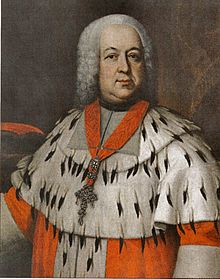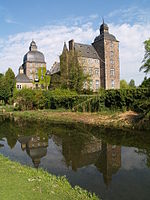Ostein (noble family)
Ostein is the name of an old noble family from Upper Rhine - Alsace . The Lords of Ostein belonged to the Upper Alsatian nobility with headquarters on the Motte Ostein near Issenheim . They later came into possession and prestige, especially in the Rheingau , were elevated to the rank of count in 1712 and, with the inheritance of the imperial rule of Myllendonk in 1732, also came to the imperial estate and thus to the high nobility . They provided a prince-bishop of Basel and an elector-archbishop of Mainz. In 1809, the male line died out.
history
origin
The first member of the family appears in 1135 as a ministerial officer of the Murbach monastery . After Kneschke , Petrus von Ostein also belongs to the family, he was elected abbot of the Murbach monastery in 1429 .
The family line begins with Johann Jacob von Ostein , Princely Murbach Councilor and Oberamtmann zu Gebweiler , who appears in a document from 1579. Ostein (also Schloss, Burg or Motte Ostein), the family seat of the same name, is not far from Rufach and Issenheim in Upper Alsace.
Spread
Until the middle of the 16th century, the family remained under the influence of Murbach and the neighboring rulers. Later relatives of the Ostein became members of the cathedral chapters of Würzburg , Bamberg , Augsburg , Eichstätt , Basel and Comburg . At the end of the 18th century, the Lords of Ostein belonged to the imperial knighthood in the Rhenish knight circle . By 1700 they were already enrolled in the knightly canton of Odenwald in the Franconian knight circle . In 1696, the Würzburg canon Johann Heinrich von Ostein was a member of the knightly canton Kocher of the Swabian knightly circle because of the Ebersberg acquired in 1694, which was sold again in 1698 .
Johann Heinrich von Ostein died in 1646 as Bishop of Basel , an office that he had exercised since 1628. His brother Johann Theobald von Ostein (* 1587; † 1651) was Obervogt of the Birseck reign . Johann Jacob von Ostein († 1664), a nephew of Johann Heinrich, became a princely Basel privy councilor and court master of Pruntrut . His son Johann Franz Sebastian von Ostein (* 1652; † 1718) was born on December 22, 1711, the coronation day of Emperor Karl VI. To Frankfurt for Knights of the Holy Roman Empire defeated and in 1712 imperial counts charged. In 1687 he married Countess Anna Charlotte von Schönborn (* 1671, † 1746). The counts Johann Friedrich Carl and Johann Franz Heinrich Carl emerged from the marriage.

Johann Friedrich Carl Graf von Ostein (* 1689) died as Elector of Mainz in 1763 . Archbishop of Mainz since 1743 , he was also elected Bishop of Worms in 1756 . His brother Johann Franz Heinrich Carl Graf von Ostein (* 1693; † 1742) was the Imperial Real Privy Councilor, envoy to the Imperial Russian and Royal English courts and from 1741 President of the Imperial Councilor . He was able to continue the family line. From his first marriage in 1732 with Maria Anna Johanna Countess von Berlepsch (* 1707; † 1737), widowed Countess von Berlepsch and heiress of Myllendonk , he had a daughter and a son.
The daughter Countess Maria Charlotte (* 1733) married Carl Friedrich Graf von Hatzfeld (* 1718, † 1793), the Austrian Minister of State in 1755 . Son Johann Friedrich Carl Maximilian Graf von Ostein (* 1735), Lord of Maleschau and Suchdol in the Kingdom of Bohemia , zu Datschitz and Markuretz in the Margraviate of Moravia and owner of the free imperial rule of Myllendonk near Gladbach am Rhein, became imperial and Kurmainzer privy councilor and chamberlain . In 1759 he married Ludovike Charlotte Freiin Kämmerin von Worms, known as von Dalberg . With his death in 1809, the male line died out .
Status surveys
The brothers Johann Friedrich Carl, initially electoral Mainz privy councilor, cathedral custodian in Mainz , provost of Frankfurt and later archbishop and elector of Mainz, Ludwig Carl Johann Eckenberth, electoral Mainz and episcopal Bamberg privy councilor and chamber president, Heinrich Carl, imperial chamberlain and imperial court councilor , Johann Franz Wolfgang Damian, cathedral capitular in Bamberg, Lothar Johann Hugo Franz, episcopal Eichstätter privy councilor and cathedral capitular and Ludwig Wilhelm Johann Maximilian von Ostein, electoral Mainz treasurer, were raised to the imperial counts on December 8, 1712 with the salutation high and well-born .
1766 Johann Friedrich Carl Maximilian received Count of Ostein for possession of domination Myllendonk the kingdom estates of the Westphalian Count College with a seat and vote on the diets .
Possessions

- Myllendonk Castle on the Lower Rhine came to the family of the Counts of Ostein (until 1794) through the marriage of Johann Franz Heinrich Carl Graf von Ostein (* 1693; † 1742) to Maria Anna Johanna Countess von Berlepsch (* 1707; † 1737). As compensation for the loss on the left bank of the Rhine, according to § 24 of the Reichsdeputationshauptschluss of February 25, 1803, the secularized Buxheim Monastery (also called Buxheim Abbey or Charterhouse ). It remained in the family until the death of the last Count von Ostein, Johann Friedrich Karl Maximilian Amor Maria, in 1809 and then became the property of Count Waldbott von Bassenheim .
- The Osteiner Hof in Mainz. Imagined family seat of the Counts of Ostein, builder was Johann Franz Wolfgang Damian von Ostein.
- The Bassenheimer Hof in Mainz. Originally the widow's seat of the sister of Elector Johann Friedrich Karl von Ostein.
- Oberamtmannhaus in Amorbach , at that time the official seat of Johann Franz Wolfgang Damian von Ostein in Amorbach, today the princely leiningsche residence.
- The Ostein-Riedheim-Hof in Eichstätt, built in 1730 as a canon court for Lothar Johann Hugo Franz von Ostein .
- In Eichsfeld the summer residence of the Elector Schloss Bischofstein and after 1751 the Tastungian fiefdoms in Bernterode .
- The Ostein Palace in Geisenheim , a horseshoe-shaped complex built from 1766 to 1771 and summer residence of the last Count of Ostein, Johann Friedrich Karl Maximilian Amor Maria Graf von Ostein. The middle section was demolished in 1811 due to inheritance disputes. Today the palace with the adjoining Eberbacher Hof and the Kronberger Hof is used by the Sankt Ursula Gymnasium.
- The Niederwald hunting lodge , built in 1764 by the last count on the Niederwald near Rüdesheim , is now used as a hotel and restaurant.
coat of arms

The family coat of arms shows a jumping red-tongued golden greyhound with a ringed silver collar in blue. The greyhound growing on the helmet with blue and gold helmet covers .
Historical representations also show red and silver helmet covers.
Name bearer
- Johann Franz Heinrich Carl von Ostein (1693–1742), imperial lawyer, real secret councilor and ambassador
- Johann Friedrich Karl Maximilian von Ostein (1735–1809), last Count of Ostein
- Johann Friedrich Karl von Ostein (1689–1763), Elector and Archbishop of Mainz and Bishop of Worms
- Johann Heinrich von Ostein (1579–1646), Prince-Bishop of Basel
- Lothar Johann Hugo Franz von Ostein (* 1695 † 1759) was an imperial, Kurmainzer, Eichstätter and Augsburg Privy Councilor who u. a. from 1729 cantor in the prince-bishopric of Würzburg, since 1711 canon in the diocese of Eichstätt and Augsburg, since 1746 provost of St. Moritz. He was u. a. the brother of Johann Friedrich Karl von Ostein
Individual evidence
- ↑ Emma Chatelain: von Ostein. In: Historical Lexicon of Switzerland . March 23, 2009 , accessed June 13, 2019 .
- ↑ a b c New General German Adels Lexicon Volume 7, Pages 4–5
- ^ Genealogisches Handbuch des Adels , Adelslexikon Volume X, Volume 119 of the complete series; Page 68
- ↑ a b Historical Lexicon of the German Lands. The German territories from the Middle Ages to the present. 7th, completely revised edition. CH Beck, Munich 2007, ISBN 978-3-406-54986-1 , p. 501.
- ↑ Pedigree of Nicolaus Franz Carl Fridolin Freiherr von Schönau, 1741 at monasterium.net
literature
- Genealogisches Handbuch des Adels , Adelslexikon Volume X, Page 68, Volume 119 of the complete series, CA Starke Verlag, Limburg (Lahn) 1999, ISBN 3-7980-0819-1
- Ernst Heinrich Kneschke : New general German nobility lexicon . Volume 7, Friedrich Voigt's Buchhandlung, Leipzig 1867, pages 4–5. ( Digitized version )
- Gerhard Köbler : Historical lexicon of the German countries. The German territories from the Middle Ages to the present. 7th, completely revised edition. CH Beck, Munich 2007, ISBN 978-3-406-54986-1 .
Web links
- Emma Chatelain: Ostein, from. In: Historical Lexicon of Switzerland .
- Family coat of arms of the von Ostein family in Johann Siebmacher's coat of arms book (1701)
- The Osteiner Hof in Mainz , website by Bernhard Peter
- Ancestral samples of Johann Franz Freiherr von Ostein and Hanß Franz Carl von Ostein on monasterium.net

